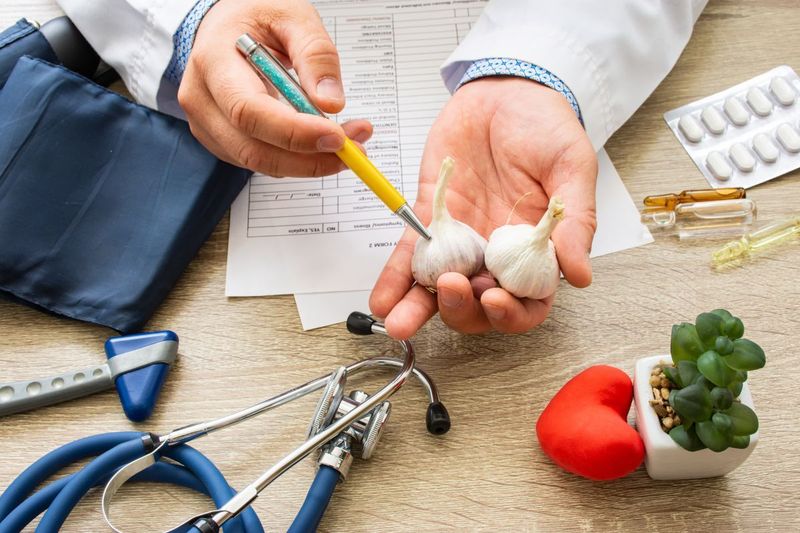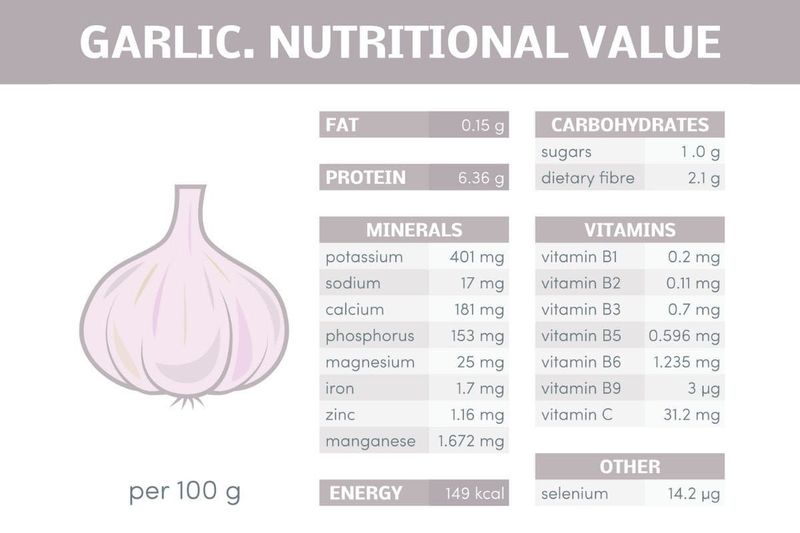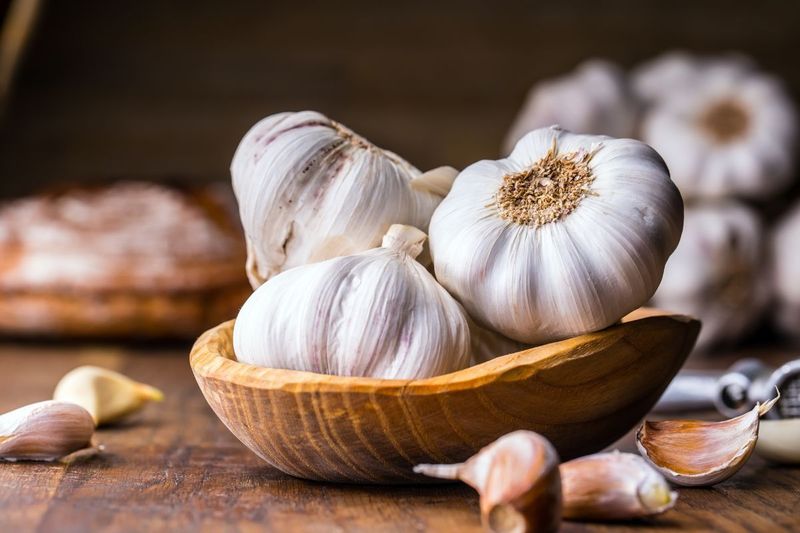Garlic’s healing properties have been a major part of multiple ancient cultures and religions ever since the dawn of human history. In Ancient Egypt, the health benefits of garlic were well known, as the working class was fed garlic regularly to help them work harder. In the Bible, Jewish people were also fond of garlic and spoke about it at length throughout many of its pages.
Over the centuries, garlic’s medicinal uses were spoken about widely by many cultures…and as modern medicine gained a better insight into garlic nutrition facts, it became clear: garlic does have many amazing benefits, particularly when eaten regularly. In fact, it’s something of a superfood and can provide a myriad of advantages and health boosts that make it critical for your overall health.
In this article, we’ll examine some common medical uses of garlic, help you understand its nutritional value, and get a deeper look at this amazing food and how it can help you stay strong. No matter what your take on garlic — some love it while others struggle with it — it’s worth understanding the benefits of this amazing food and the ways it could help your health and well-being.
Health Benefits of Garlic
When examining garlic healing properties and the health benefits of garlic, it’s worth diving into the scientific aspects to explain garlic’s medicinal uses. Garlic nutrition facts will be discussed later to further examine the unique benefits of this high-quality food and its use in many food cultures.
Garlic’s Antimicrobial Properties
As one of the most popular food spices in the world, garlic’s antimicrobial properties have been heavily studied and confirmed by many specialists in recent years. It contains compounds like allicin, ajoenes, and allyl sulfides that all fight against various microbes and keep your body healthy.
In fact, the World Health Organization has not only recognized the importance of fighting antibiotic resistance — a condition in which antibiotic medications don’t work for people — but also found healthy natural alternatives using things like garlic and other types of very healthy foods.
Garlic’s Anti-inflammatory Effects
Inflammation is a common side effect of various diseases and can be quite painful and hard to tolerate. Thankfully, things like garlic can help fight against inflammation and keep people healthier. Medical science has identified organosulfur compounds in garlic that help manage inflammation.
In one study, it was found that these compounds could help with cancer chemoprevention and make this process go more smoothly. That’s an amazing benefit (many people need inflammation support during chemotherapy), making garlic a smart choice for people trying to stay healthy.
Garlic’s Antioxidant Capacity
You’ve probably heard all about antioxidants from various medical shows on television: there’s a reason for that. The discovery of these problematic items triggered a revolution in medical science, particularly in identifying powerful all-natural ways of getting oxidants out of the body.
During these studies, garlic was quickly identified as one of the most potent antioxidants available. It helps with gastrointestinal digestion and much more, making it a powerful therapy for many conditions. If you’re a fan of garlic (or even if you don’t like it much), it’s worth trying it out.

Medicinal Uses of Garlic
Garlic healing properties and the health benefits of garlic have been confirmed by medical science, and garlic’s medicinal uses tie heavily to garlic nutrition facts. However, the amazing nature of this food isn’t a modern discovery: ancient wisdom has highly prized garlic for thousands of years.
Garlic in Traditional Medicine
Earlier, we briefly touched on the lengthy history of garlic in traditional medicine. We discussed how Egyptians fed it to their workers and how it spread to Jewish culture through this exchange. However, Chinese people believed garlic treated respiratory and digestive issues: they were right, too.
In old Greece, garlic was also used for various respiratory illnesses but was commonly implemented to manage wounds, infections, and much more. That usage spread to Rome, where garlic was used to manage kidney issues, snake bites, dog bites, and insect bites…surprising considering its limitations.
Furthermore, even medieval Europe utilized garlic to fight off diseases and evil spirits. Where do you think the myth that garlic repels vampires originated? Clearly, these individuals understood the power of garlic to a degree but may have actually underrated it as a healing totem: shocking, we know.
Modern Medical Applications of Garlic
While garlic might not be the miracle food that ancient civilizations loved (it can’t help much with bug bites, for example), modern science has confirmed a dazzling array of health benefits of garlic. Various studies have confirmed the possible benefits of garlic when managing:
- Common Cold: Though medical science is still out on the full benefits of garlic in managing colds, at least one study found that there were real benefits, including reducing symptom severity.
- Infections: We already discussed garlic’s antibiotic properties earlier, but we want to emphasize them here by linking to a study showing how it may help with infections.
- Cholesterol: At least one study finds that garlic can help manage your cholesterol levels, which can help your heart health and minimize long-term health risks that could impact you.
- Immune Health: Garlic may help boost immune system health and help you better fight various colds, cases of flu, and other health problems that may rapidly spread and affect you.

Nutritional Value of Garlic
Garlic healing properties and the health benefits of garlic come heavily from the various vitamins and minerals within this food. If you’re interested in adding it to your diet, there are several things you need to know, including the macronutrient and micronutrient levels common in this food.
Macronutrient Content of Garlic
When examining garlic nutrition facts, it’s important to examine the macronutrients first: these include the larger and more extensive nutrients that can affect garlic’s value to your diet. Well, garlic is fascinating because it has a three-gram serving and is one of the healthiest things you can eat:
- Calories: 4
- Fat: 0.02 grams
- Protein: 0.19 grams
- Carbohydrates: 0.99 grams
- Sugars: 0.03 grams
- Fiber: 0.06 grams
- Saturated Fats: 0 grams
Micronutrients in Garlic
Micronutrients refer to the vitamins and minerals in your food, and these vary heavily depending on what you eat. Garlic provides a pretty strong amount of various nutrients and is a great addition to any diet. Here are a few of the most important micronutrients that you can find in a three-gram serving:
- Calcium: 5.4 mg
- Iron: 0.05 mg
- Potassium: 12 mg
- Magnesium: 0.75 mg
- Phosphorus: 6 mg
- Sodium: 0.51 mg
- Zinc: 0.03 mg
Garlic also has trace amounts of copper, manganese, selenium, vitamin A, multiple B vitamins, biotin, folic acid, food folate, beta-carotene, alpha-carotene, and lut + zeaxanthin. Though it doesn’t have these items at a high level, it has enough to make it a pretty healthy food for your diet.
Garlic for Specific Health Concerns
Garlic’s medicinal uses are very diverse and make sense, considering garlic nutrition facts. No matter what garlic healing properties you want to activate, knowing how to tap into garlic’s medicinal uses for specific conditions can ensure you get great results. Here’s what you need to know.
Strengthening the Immune System with Garlic
Try to integrate healthy raw garlic into your diet daily. Doctors suggest eating one-half of a raw garlic glove or, if you can’t handle it raw, toasting it. Toasting does remove some of its nutritional value but can ensure that you get the help you need to keep your immune system strong and healthy.
Promoting Heart Health with Garlic
Adding a little chopped garlic to your food — such as roasting vegetables or even eggs with it — can help introduce this delicious ingredient into your diet. Eating about a half-clove (that seems to be the sweet spot) should help boost your heart health and keep you protected for years to come.
Enhancing Skin and Hair Health with Garlic
Garlic’s vitamin-rich content makes it very beneficial for various skin-health issues, including acne and scarring. Apply it directly to your skin with a puree, eating raw gloves, drinking garlic juice (oof), or even mix it with yogurt (or water) to make it a little easier for your stomach to tolerate.
Garlic for Weight Loss: Myth or Reality?
People who eat garlic regularly seem to lose weight, according to more than one study. The benefits here include a boost in your metabolism and a decrease in appetite…that makes garlic not only a fun and tasty topping but a great way to keep your belly fat under control as you age.
Incorporating Garlic into Daily Life
If you’re interested in tapping into garlic’s healing properties and getting the most benefits from garlic’s medicinal uses, try these techniques. That taps into garlic nutrition facts and makes it easier to implement this sometimes challenging food into your day-to-day dietary schedule.
Adding Garlic to Everyday Recipes
Chop garlic before cooking and add it directly to your recipes. For example, sprinkle it on top of your favorite steak and let the oil marinate the meat to infuse it with its many benefits. You can also top your foods with garlic after they’re cooked or add it during the cooking process.
Here’s a great tip: add minced garlic to your vegetables to give them a little more taste. Not everybody can handle the unique flavors of asparagus and other veggies. By adding garlic to them (and roasting them in it), you create a healthy and tasty meal that uses garlic properly.
Garlic Supplements: Dosage and Usage Tips
Uses of garlic supplements include managing hypertension, reducing fat blood levels, helping with coronary diseases, and preventing cancer. Physicians suggest taking no more than 200-400 mg orally three times daily of standardized extract, 600-7,200 orally daily of aged extract, four grams (or one glove) orally daily, or three drops daily for topical (skin) issues.
Precautions and Considerations
Though garlic is a pretty safe food (and supplement) that causes a few issues, some people may experience side effects when using it at a high level. Allergic reactions are particularly potent and should be watched for to stay safe. Symptoms of a reaction to garlic include:
- Hives wherever you touched or interacted with the garlic
- Swelling on your face, lips, tongue, or throat (very dangerous!)
- Difficulty breathing (you need to see a doctor right away)
- Redness, swelling, and blistering (when touching your skin)
- Easy bruising or bleeding (such as nose bleeds or bleeding gums)
Other minor side effects include bad breath or body odor, heartburn (very common if you eat it just before sleeping), nausea, vomiting, excessive gas, or even diarrhea. If you experience any of these side effects, talk to your doctor and stop taking garlic to see if that’s the problem.
